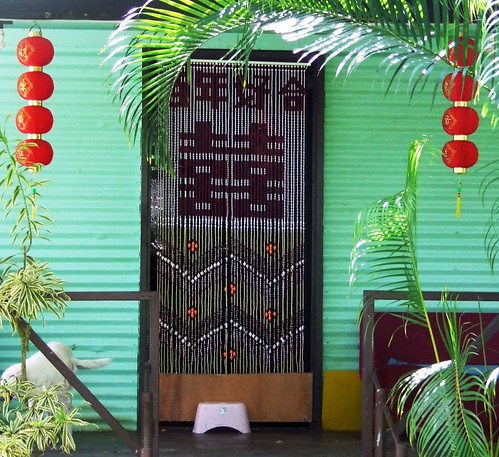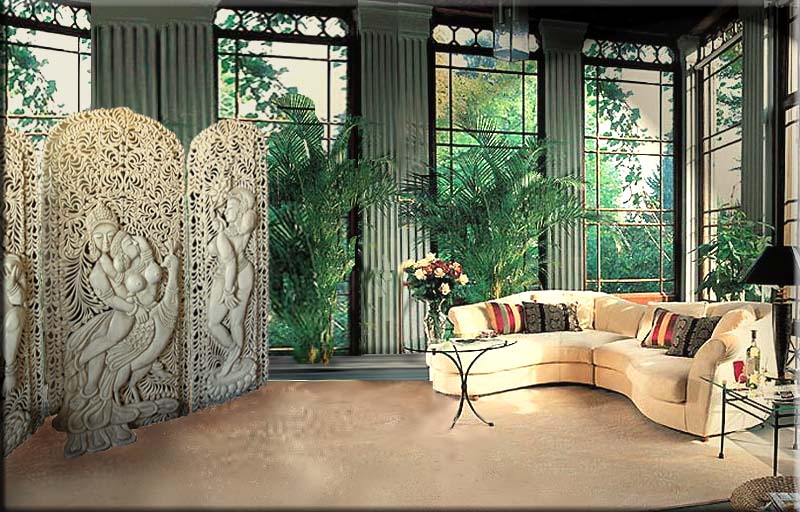



A tibetan door usually stand against the wall for keep good luck stay. A reproduction piece Made like 80years old. A tibetan door panel featuring a beautiful embossed gold front dragon with gems, the central dragon painting is surrounded by cloud patterns on a yellow background.
The bottom two panels feature a tiger and a mountain leopard. The central panel is decorated with a central dharma wheel symbol amidst cloud patterns. The border of the door panel is finished with embossed gold floral patterns on a red background . The wood panel is one of the tibetan painting art of "Thangka"The Tibetan word "Thangka" refers to the flat cloth on which paintings are produced and by extension to the images and paintings themselves.
The Tibetan art of Thangka painting is at once a folk, traditional, and sacred art: folk because it is an expression of what is essential to the Tibetan people's culture, aspirations, and principles of living; traditional because it is taught, studied, practiced, and produced according to an established, precisely transmitted body of craft and contemplative knowledge which is, in turn, a vehicle for the essence of Tibetan Buddhism.
Like other forms of sacred and traditional art, it allows truths and realities that are formless, or otherwise too subtle and profound for conceptual thought, to be 'seen' and visualized in such a way that they may be realized contemplatively.It is the practice and transmission of this traditional art of Thangka painting that I(Kumar Lama) have made my lifelong devotion, vocation, and profession. Along with painting Thangka and teaching, I am working to develop a more personal expression of the tradition, a style entirely grounded in and informed by the craft, art, and vision of Thangka, but which I use to present non-Thangka themes and content. I call these works "Scenes From The Pure Land". "The Pure Land" is wherever all phenomena, all dharmas, all appearances, are seen in a non-dual vision of reality.
The bottom two panels feature a tiger and a mountain leopard. The central panel is decorated with a central dharma wheel symbol amidst cloud patterns. The border of the door panel is finished with embossed gold floral patterns on a red background . The wood panel is one of the tibetan painting art of "Thangka"The Tibetan word "Thangka" refers to the flat cloth on which paintings are produced and by extension to the images and paintings themselves.
The Tibetan art of Thangka painting is at once a folk, traditional, and sacred art: folk because it is an expression of what is essential to the Tibetan people's culture, aspirations, and principles of living; traditional because it is taught, studied, practiced, and produced according to an established, precisely transmitted body of craft and contemplative knowledge which is, in turn, a vehicle for the essence of Tibetan Buddhism.
Like other forms of sacred and traditional art, it allows truths and realities that are formless, or otherwise too subtle and profound for conceptual thought, to be 'seen' and visualized in such a way that they may be realized contemplatively.It is the practice and transmission of this traditional art of Thangka painting that I(Kumar Lama) have made my lifelong devotion, vocation, and profession. Along with painting Thangka and teaching, I am working to develop a more personal expression of the tradition, a style entirely grounded in and informed by the craft, art, and vision of Thangka, but which I use to present non-Thangka themes and content. I call these works "Scenes From The Pure Land". "The Pure Land" is wherever all phenomena, all dharmas, all appearances, are seen in a non-dual vision of reality.


















0 comments:
Post a Comment